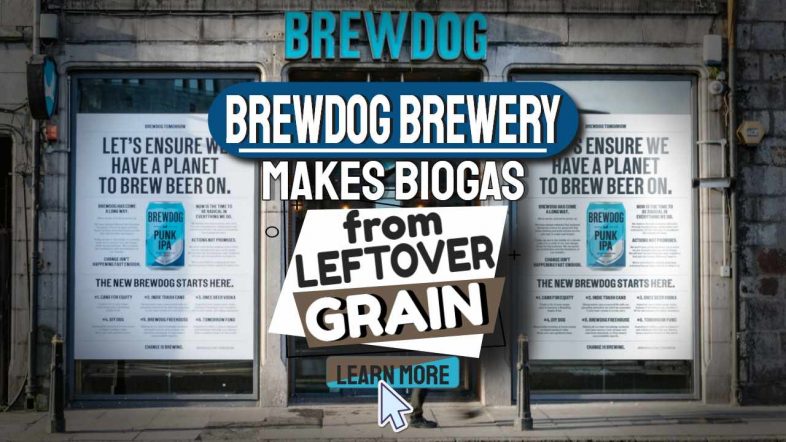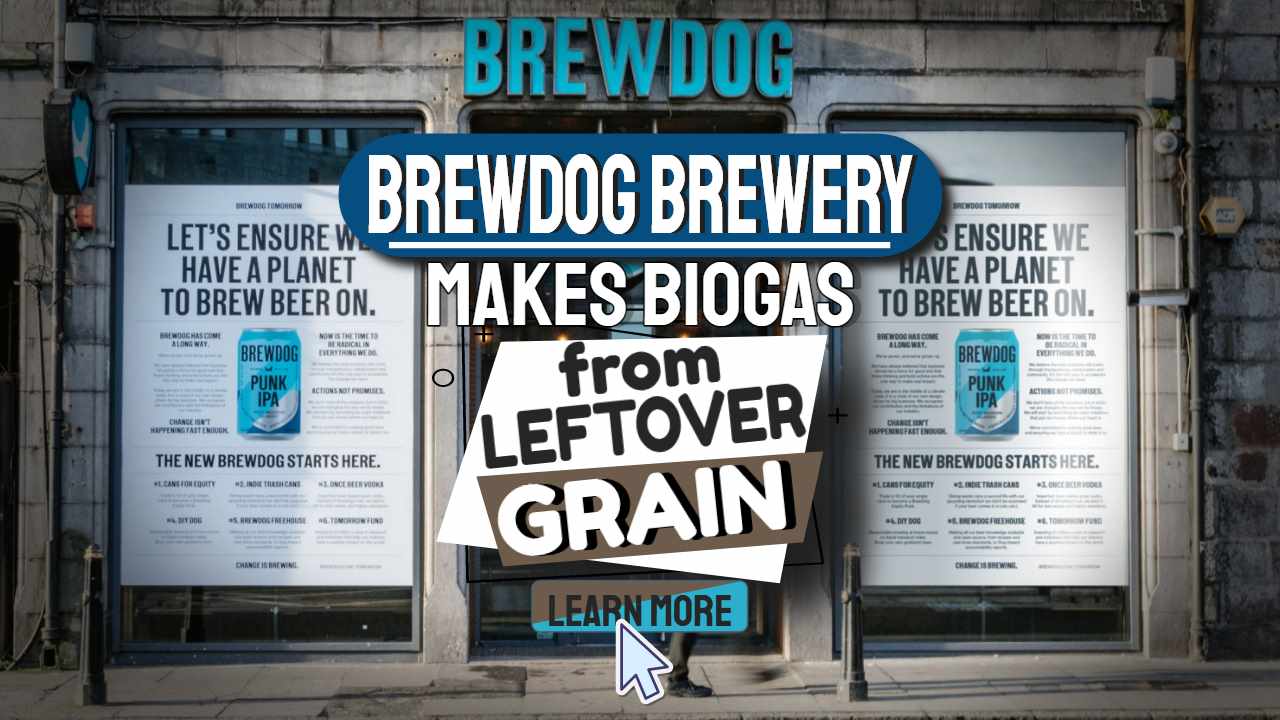The Brewdog Brewery makes biogas from leftover grain and that helps fight climate change by producing renewable energy, reducing carbon emissions. Fewer emissions mean lower global temperature rises. But, how is Brewdog's business operation overall carbon negative?
Let's start with a definition:
“Carbon negativity is achieved when a business or individual removes more carbon from the atmosphere than they put in.”
With the additional purchase of wind turbines to supply them with renewable power, BrewDog took a significant step toward achieving very low carbon emissions at the start of the 2020s.
But because there are days when there is no wind and hence no wind power, it is not a completely satisfactory option all of the time. Solar power, similarly, is not a complete answer because it produces relatively little electricity at night.
Therefore, they also invested in 24/7 biogas power, so that now these, and many other breweries, are increasingly powered by the residual grain left over after the brewing process, which is converted into biogas using the anaerobic digestion method.
Add up all the carbon emissions saved and taken out of the atmosphere, and it is more than what is put in. In other words, Brewdog's business operations are carbon negative.
Additionally, it's worth mentioning that BrewDog created a beer in 2017 titled “Make Earth Great Again” in an effort to raise awareness about climate change.
In fact, their zeal for combating climate change has only become stronger in recent years.
Continue reading to find out more.
BrewDog's Biogas Revolution: Major Developments Since 2021
£12 Million Anaerobic Digester Comes Online
In a landmark achievement for sustainable brewing, BrewDog commissioned a new onsite bio-energy plant at its Ellon headquarters near Aberdeen in June 2022, representing a £12 million investment in green technology. This state-of-the-art facility transforms brewery waste into clean energy, marking a significant milestone in their journey toward carbon negativity.
How the Anaerobic Digestion Process Works
The brewery's innovative approach to waste management centres on converting spent grain and wastewater into valuable resources. The process begins when leftover grain from brewing operations and rinse water from production are fed into specialised digesters.
Step 1 – BrewDog Brewery Makes Biogas
Through anaerobic digestion, microorganisms break down this organic matter in oxygen-free conditions, producing biogas that contains approximately 55% methane and 44% carbon dioxide.
Step 2 – Biogas Upgraded to Biomethane and CO2
Using advanced DMT biogas upgrading technology, BrewDog separates these components, creating nearly pure biomethane for energy generation and food-grade CO2 that's recycled back into their brewing process. This closed-loop system exemplifies circular economy principles by turning waste into valuable products.
Powering Vehicles and Operations
BrewDog's commitment to sustainable transportation has accelerated since 2021. The brewery partnered with Gregory Distribution for 100% electric deliveries in Central London, with Ross Watson, BrewDog's Head of Supply Chain, stating they are “excited to continue to expand our fleet of both electric and alternative fuelled transportation”.
The biogas generated from their anaerobic digestion facility provides renewable energy that runs 24/7, unlike solar or wind power, which face intermittent challenges. This consistent energy source helps power their facilities and supports their expanding fleet of electric delivery vehicles, including what they claimed was the UK's first electric 19-tonne truck.
Environmental Impact and Carbon Negativity
BrewDog's biogas initiative represents more than just waste management—it's a comprehensive approach to environmental stewardship. The company maintains its status as what it claims to be the world's first carbon-negative brewery, removing more carbon from the atmosphere than it produces through:
- Renewable energy generation from brewery waste
- Water treatment that reduces consumption by 50% at their headquarters
- Electric vehicle deployment for deliveries
- Tree planting initiatives that offset emissions
- Closed-loop packaging systems
Technical Specifications and Output
The anaerobic digestion facility processes liquid feedstock, including wash-waters and other process liquids that were previously hauled off-site. The biogas upgrading system produces multiple valuable outputs:
- Biomethane for renewable energy generation
- Food-grade CO2 for brewing operations
- Organic fertiliser from digested waste
- Clean water from the treatment process
Looking Ahead: Zero Waste Goals
BrewDog's sustainability ambitions extend beyond their current achievements. The brewery has set aggressive targets to become zero waste within 24 months of their 2022 facility commissioning, with the anaerobic digester playing a central role in this circular economy approach.
This comprehensive biogas system demonstrates how traditional industries can transform waste streams into valuable resources, setting a precedent for sustainable brewing practices worldwide.
As BrewDog continues to refine its operations, its biogas facility serves as a model for other breweries looking to reduce their environmental footprint while maintaining operational efficiency.
The success of BrewDog's anaerobic digestion facility showcases the potential for biogas technology to revolutionise industrial sustainability, proving that environmental responsibility and business success can work hand in hand.
Brewdog Brewery Makes Biogas Using DMT AD Technology
DMT delivers biogas plants and high-performance technology that removes CO2 by membrane separation, biogas pre-treatment utilising chemical and biological gas desulfurization technology and H2S removal.
DMT's products include biogas plants, high-performance technology, and H2S removal. DMT provided upgrading equipment for at least one Brewdog biogas facility, according to company officials.
This is an important step forward in BrewDog's efforts to rapidly enhance the sustainability of its operations, and we encourage other businesses to follow and build on their lead.
Biogas Upgrading at BrewDog’s HQ Bio-plant
Breweries across the world purify and reuse the rinse water that they use during the brewing process. The wastewater treatment facility at the BrewDog HQ bio-plant decreases the brewery's water use by half, resulting in significant cost savings.
During this purification procedure, a waste stream including sludge is discharged into the environment. This sludge is then moved to a digester, where it undergoes a digestion process, as a result of which biogas is generated.
It is estimated that the biogas produced by the BrewDog brewery contains 55% methane, 44% carbon dioxide, and other gases, including contaminants such as hydrogen sulphide (H2S).
Biogas upgrading entails splitting the gas into two major streams, one of which will be almost 100% pure carbon dioxide and the other of which will be more than 90% biomethane.
Since the CO2 may be reused in the brewery's production process, it can help to reduce CO2 emissions while also completing the loop by utilising the CO2 as a product that would have otherwise gone to waste.
Brewdog looks to future sustainability
BrewDog beer is for everyone who lives on this planet, and that is the message that is being sent. The video concludes with a demonstration of the brand's most tangible sustainability initiative:
‘we're the world's first carbon-negative brewery, and we plant trees for every beer you drink,'
which leaves the viewer with an optimistic and actionable message that can be used to help influence buying behaviour.
They are, without a question, the future, but we need other businesses to follow their example right now.
BrewDog, the Scottish Carbon Negative Brewery, Thanks to Biogas
Brewdog is a carbon-negative brewery in Scotland, made possible almost entirely by biogas.
Brewdog, one of the largest Scottish craft brewers, has been designated as the world's first carbon-negative beer brewery, according to the United Nations Environment Programme.
These include the commissioning of a biogas plant at the brewery's Ellon facility, which will run on waste from the brewery. Brewdog, one of the major Scottish Craft Breweries, has been designated as the world's first carbon-negative beer brewery, surpassing the previous record set by a German brewery.
Brewdog Brewery Makes Biogas: A Sustainability Update
BrewDog, a Scottish craft brewer, has stated that it has accomplished the unusual step of being carbon negative, meaning that it will remove twice as much carbon dioxide from the atmosphere as it emits in a single calendar year.
The tagline of the ad,
‘Beer for All,'
states that the promotion of environmental consciousness is based on the notion of environmental conscience;
“Helping to make the world a better place for everyone who drinks BrewDog. And even those who don't believe it.”
Brewdog’s sustainability report wants to raise awareness of any company that has a net-zero objective scheduled for later than 2030 and invites criticism.
According to the IPCC's report, 2050 was the absolute latest date by which global emissions could be brought to zero and global warming limited to 1.5 degrees Celsius.
This means that organisations and countries with the ability to move more quickly must do so in order to increase the likelihood of meeting the Paris Agreement's target of 1.5 degrees Celsius.
Say Hello to Sustainable Beer Down Under!
Brewdog Australia is also interested in collaborating with environmentally conscious businesses, all of which have received the highest level of accreditation. Plans call for the establishment of a sustainable drive-thru that will serve as:
- a beer collecting point,
- a centre for electronic vehicle deliveries, as well as
- a hub for closed-loop, zero-waste packaging, including bottles that are returnable and
- include growling dog style filling stations.
It goes without saying that some of these procedures need a significant amount of energy, and the fermentation process generates waste products such as malted barley and water which can be used to make that.
Before the efforts of Brewdog and other biogas enthusiasts, there was previously thought to be no way to overcome these difficulties. However, there is now some really sustainable progress!
[Published on: 21 November 2021. Updated August 2025.]






I really wish America could take a cue from this and stop wasting as much food (730 football stadiums worth per year) as they do.